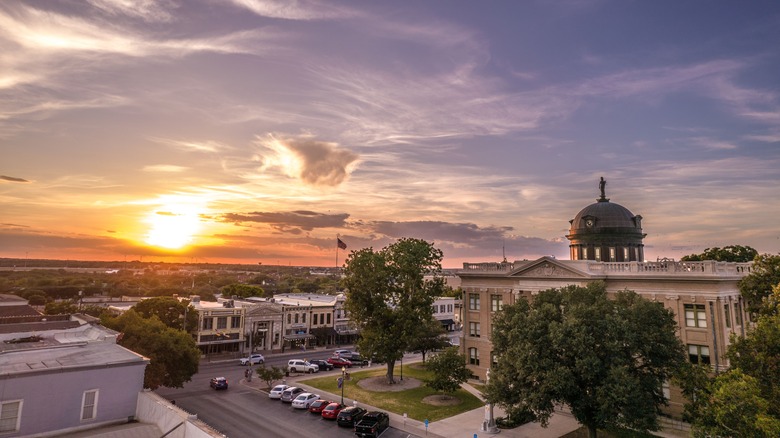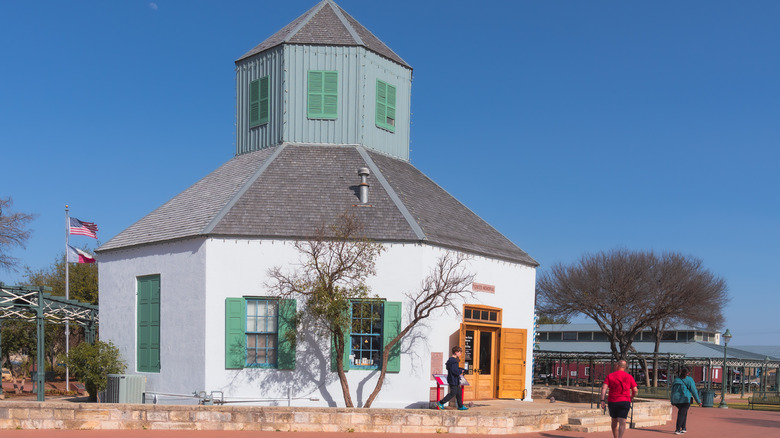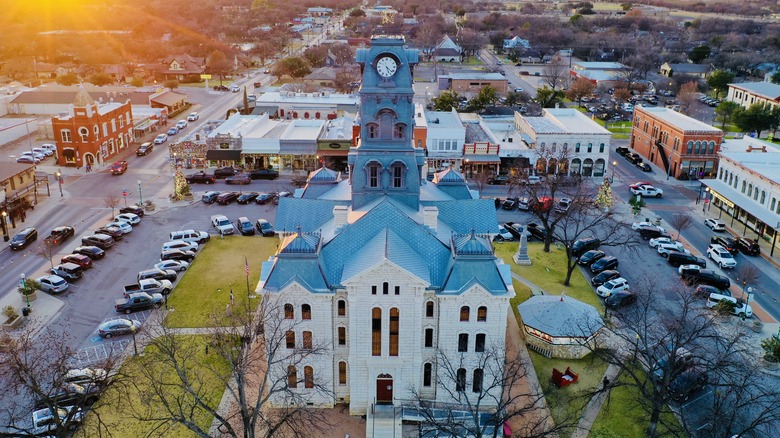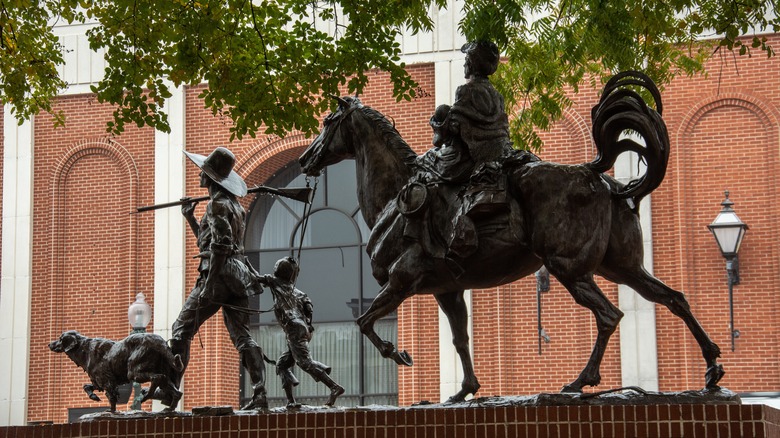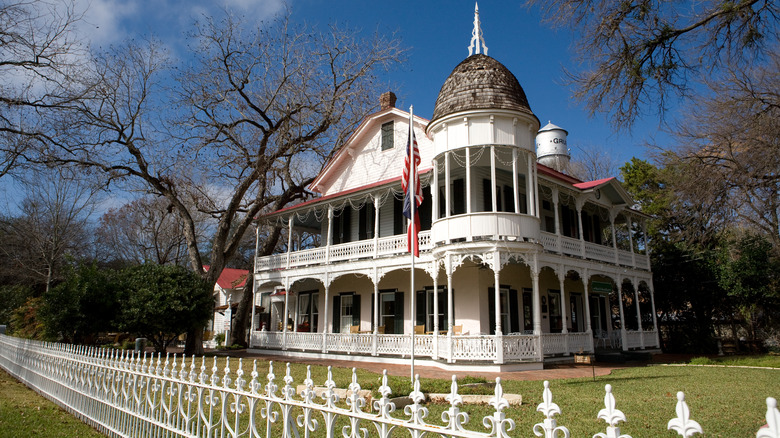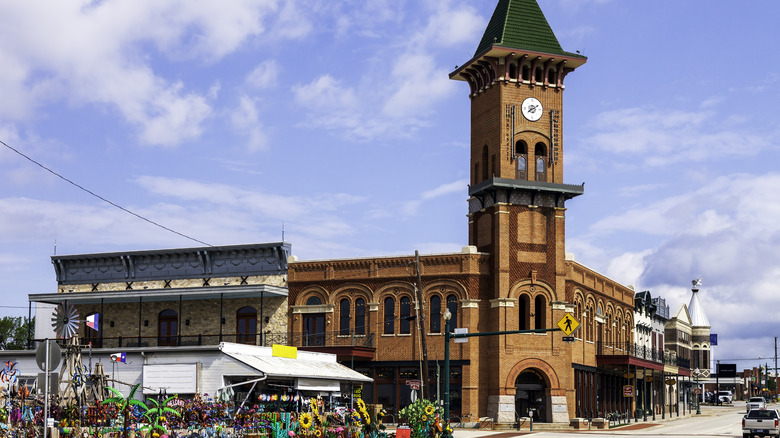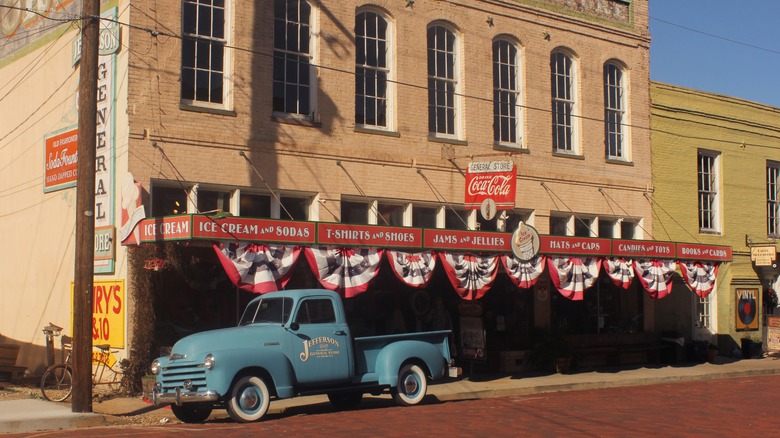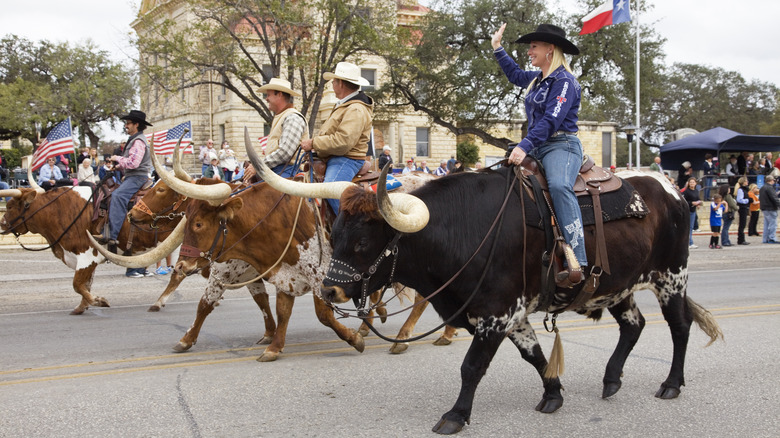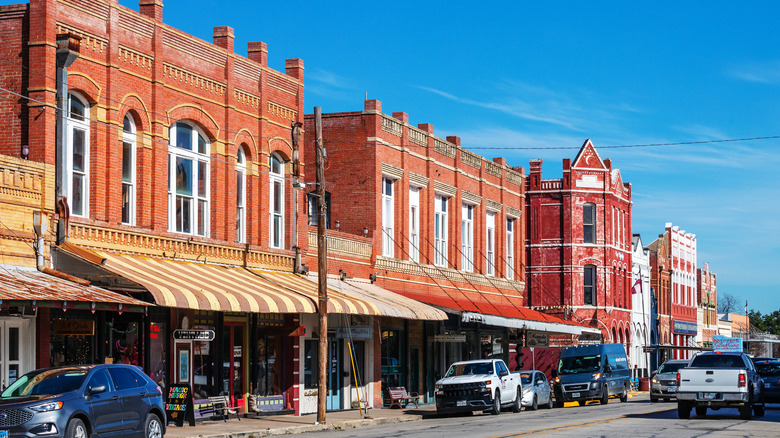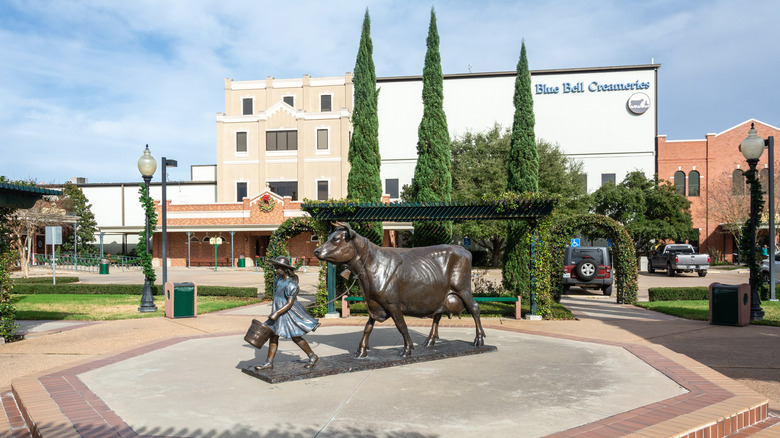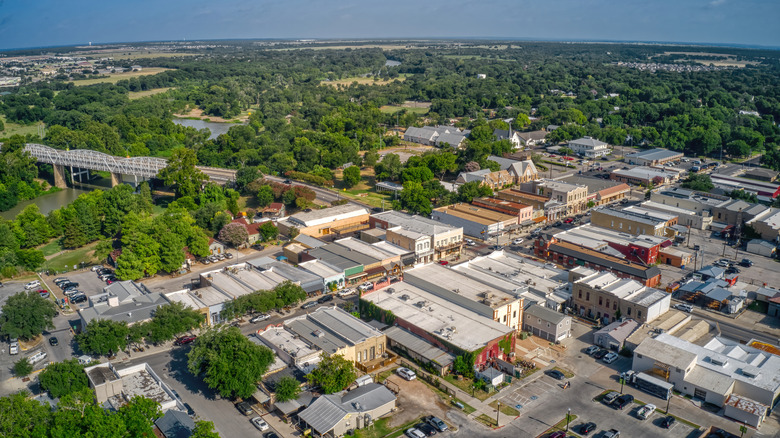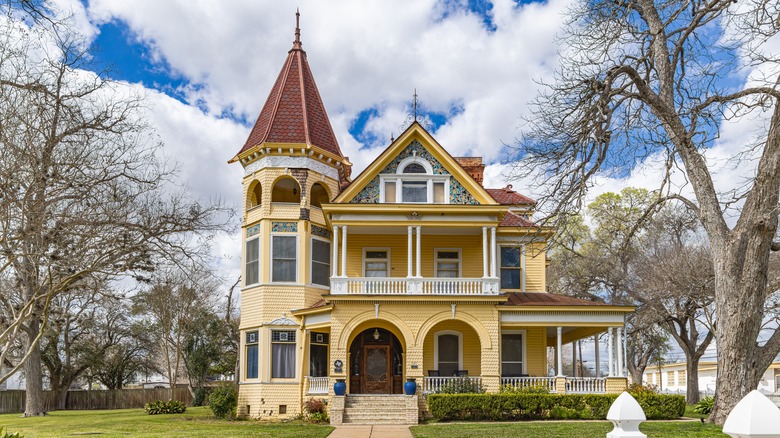These Charming Main Streets In Texas Capture The Heart Of Small Town Life, According To Visitors
It's true what they say: Everything is bigger in Texas. From its sprawling ranches to its bustling cities, the Lone Star State has earned its reputation for the big and bold. But some of Texas's greatest treasures are found off the beaten path, away from the skyscrapers and tech giants, in the small towns that dot the state's countryside.
Across the state, dozens of historic main streets offer a step back in time to explore Texas history, full of architectural marvels and lively street festivals. More than just charming spots to eat and shop, these towns are connected by common threads: walkable downtowns, preserved landmarks, and Texan hospitality. Yet each one has its own story to tell, be it unique culinary traditions, seasonal celebrations, historic sights, or just a sense of community and comfort that's hard to find elsewhere. Here are some of the most warm and welcoming small towns that capture the true soul of Texas.
Georgetown
About 30 miles north of Austin, Georgetown is a well-known weekend getaway for Austin city dwellers looking for something trendy and low-key. And, given that it was the very first Texas city to win the Great American Main Street Award in 1997, it'd be fair to say that this slice of Texas Hill Country sets the bar for charming downtown districts. Its town square is anchored by the historic Williamson County Courthouse, a grand Classical Revival building with stone Ionic columns and a copper dome. The surrounding streets are lined by impeccably preserved Victorian storefronts — in fact, there are more than 180 homes and businesses listed on the National Register of Historic Places in the surrounding historic districts, of which there are three. Among the preserved storefronts, you'll find a mix of boutiques, cafes, bars, art galleries, and even a local history museum set in an old bank building.
What really sets this little city apart, though, are its trademark red blossoms you'll see when strolling down the street in spring. Known as the "Red Poppy Capital of Texas," the scarlet flowers that can be found throughout the city are rumored to be a remnant of a World War I soldier's gift to his mother that propagated across town until they eventually became a local symbol. Today, this unique piece of Georgetown's past is celebrated each April with the annual Red Poppy Festival, which fills the streets with live music, entertainment, and hundreds of poppies in peak bloom. Although visitors on Reddit warn that the festival can be crowded, they agree that the quaint town square and beautiful blossoms are worth the effort.
Fredericksburg
Few towns wear their heritage on their sleeve quite so proudly as Fredericksburg. The Central Texas town was first settled by German immigrants in 1846 and by the 1920s, around 97% of the population was estimated to speak a unique dialect called Texas German. While the language isn't nearly as popular today, locals and visitors alike on Reddit confirm you'll still hear plenty of people fluent in it, and Fredericksburg's European roots ultimately draw hundreds of thousands of visitors annually. Take a stroll around the central Marktplatz and you'll run into traditional German biergartens and bakeries selling strudels and Bavarian crumb cakes. At the heart of the town square is the Vereins Kirche Museum (German for "Society's Church"), a replica of the oldest structures in town that now showcases artifacts depicting Fredericksburg's distinct cultural history.
If you're thinking about planning a trip, you might want to time your visit for the first weekend of October, when you can grab a slice of German food at the town's famous Oktoberfest. Fredericksburg is also known for its large concentration of bed and breakfasts, so you can experience the town like a local whenever you choose to visit.
Granbury
It's difficult to pin down just one feature that makes Granbury stand out. Is it the historic town square dotted with shops and restaurants? Perhaps its reputation as the "Celebration Capital of Texas?" Or the downtown beach that's about 300 miles inland? Whatever the case, one thing is for certain — that Granbury has a little something for everyone, which explains why tourism is the city's top industry.
The picturesque downtown square is home to old-timey saloons and New American lounges alike, all surrounding the iconic Hood County Courthouse. The massive French Second Empire structure can be seen from most parts of the city, with three stories of restored limestone brick topped off by a grand clock tower. The surrounding streets house even more historic sights, from an 1885 town jail-turned-museum and the newly-renovated opera house that's been bringing live theater to Granbury since the late 19th century. For those whose love for history leans a bit more morbid, it's worth taking a ghost tour of the town — famous names such as Jesse James and John Wilkes Booth were once said to have passed through.
After a long day of exploring Granbury's historic and culinary delights, there's no better way to unwind than with a visit to City Beach on Lake Granbury, described by visitors on Google Reviews as placid and serene. "Walking along the lake was one of our favorite moments — so relaxing and scenic. A perfect little getaway for some quality family time," said one traveler. You'll need the rest before checking out the city's jam-packed events calendar, which, rather than centering on a few annual festivals, ensures there's something new to explore on every day of the year.
Nacogdoches
Known as the oldest city in Texas, Nacogdoches' history can be traced back nearly 250 years to its founding in 1779. While Texas famously has flown six flags since it was first settled (Spain, France, Mexico, the Republic of Texas, the Confederate States, and the United States), nine flags have flown over Nacogdoches over the course of two and a half centuries. The other three flags? An early army called the Gutiérrez-Magee Expedition, the failed Long Republic, and the rebel Republic of Fredonia.
In Nacogdoches, history lives on all up and down Main Street in numerous early-settlement buildings and roads paved in distinctive red brick that give the city its timeless character. While there are always plenty of antique shops, restaurants, and arts venues to discover in downtown Nacogdoches, the city is especially lively during the Texas Blueberry Festival every June, when around 17,000 people converge downtown for festivities like a pie-eating competition and a blueberry pancake breakfast. Per Yelp reviews from festival-goers, Brookshire Brothers provides locally-grown blueberries starting at $2.50 a pint — a price that easily beats most grocery stores.
The presence of Stephen F. Austin State University just north of downtown also lends the city a vibrant college-town feel. A trip to campus is well worth the detour if only to visit the Stone Fort Museum, where Nacogdoches' singularly long history comes to life in the stories of early East Texas frontiersmen.
Gruene
Once a bustling cotton town along the Guadalupe River, the German-Texan enclave of Gruene boasts a downtown National Historic District that spans 15 acres. Situated between San Antonio and Austin, this tiny Texan town has been keeping its history alive since the 19th century with carefully-preserved turn-of-the-century buildings that now house a vibrant array of specialty boutiques and riverfront grills that line Gruene Road. Take a walk and you'll find a century-old cotton gin, Victorian estates, and a grist mill turned restaurant.
The heart of it all is Gruene Hall, which has stood since 1878, making it Texas' oldest continuously-operating dance hall. Over the years, it's hosted legends from George Strait to Garth Brooks and all flavors of up-and-coming Americana artists. While the old dance hall might look like a set from an old Western from the outside, its dance floor is still as lively as ever on Friday nights. Be sure to grab weekend tickets early, as local guides on Google Reviews warn that they often sell out.
Gruene's riverside setting isn't just a scenic backdrop, either — the Guadalupe River (known locally as the Hill Country Coast) offers a calm stretch of water for canoeing, kayaking, and fly fishing. At Rockin' R River Rides, you can even rent a tube and go for a drift without having to leave downtown.
Grapevine
True to its name, Grapevine boasts first-rate wines, but this small city offers far more than just a good vintage. Nestled between Dallas and Fort Worth, its Historic Main Street District is home to architectural marvels ranging from Victorian-era shop buildings, log cabins, and a still-operating early 20th-century train station. Visitors can board the Grapevine Vintage Railroad for a scenic ride along the Historic Cotton Belt Route, which once ferried crops between rural North Texas and the Fort Worth Stockyards. Other trips aboard the century-old locomotives include themed excursions like jazz wine trains and holiday specials.
But the vintage railroad isn't the only thing that's always in motion — the city is known for its calendar stuffed with events and festivals. Among the most famous is GrapeFest, which holds the high honor of being the biggest wine festival in the Southwest, attracting over 200,000 people for wine tastings, a champagne cork shoot-off, and a grape stomping competition. If you miss the festival season, you can still taste all that Grapevine has to offer along the urban wine trail, which highlights nine of the city's tasting rooms. According to vacationer accounts on Tripadvisor, Grape Vine Springs Winery carries some of the city's best sweet wines, while other reviews claim that Cross Timbers Winery is a must-visit for their Grapevine Red. Come December, downtown transforms into a bona fide winter wonderland that's been officially designated the "Christmas Capital of Texas." With more than 1,400 Christmas events to explore each holiday season, guests and residents alike are bound to stay busy all season long.
Jefferson
Tucked away in the pines of East Texas, Jefferson doesn't quite feel like most Texan towns. Rather than Wild West saloons and honky-tonk bars, Jefferson's bayou charm feels closer to New Orleans than it does Dallas. That's no mistake, either — during its heyday in the mid-1800s, it was a bustling inland port that rivaled New Orleans in antebellum mansions and steadily-chugging steamboats. The town's prosperity came to an abrupt end in 1873, when a dam was removed and the Big Cypress Bayou shrunk, making it unnavigable to steamboats. Today, Jefferson has made the pivot from being a river port mecca to becoming a well-preserved, pre-Civil War tourism destination.
The town's historic architecture, brick-paved streets, and flickering gas lamps lend to an atmosphere that's both romantic and mysterious. Carriage rides, trolley tours, and bayou boat trips are all popular ways to explore Jefferson's storied past and stunning architecture, but don't be surprised if something feels a bit eerie. Jefferson is often described as the most haunted town in Texas, with dozens of local legends centered around some of the town's oldest buildings. The Jefferson Hotel is perhaps the most well-known and calls itself "the most haunted hotel in the world," with ghostly activity reported in every single one of its rooms. Past visitors frequently mention paranormal activity: "We heard loud strange noises coming from the inside of the walls and got photos of orbs in the hotel," said one user on Google Reviews. Any aspiring ghost hunters or other brave souls can book a room and see for themselves.
Bandera
Stepping into Bandera is a lot like stepping into a Western movie set, complete with wooden frontier facades and the sound of horses clopping down the street. So it should come as no surprise that the town is heralded as the "Cowboy Capital of the World" — and between all the ranches, rodeos, and horseback riding, that title isn't just for show.
Downtown Bandera is part modern main street and part living cowboy museum, a combination that's exactly as quirky as it sounds. Even contemporary conveniences like auto stops and salons are styled to look like Wild West outposts. It isn't even particularly uncommon to see horses hitched outside of any one of the downtown saloons, thanks to the city's official BYOH (bring your own horse) policy. Among the can't-miss stops is Arkey Blue's Silver Dollar, the oldest continuously operating honky-tonk in Texas. Beneath its sawdust floors and neon lights, the stage has welcomed country icons like Willie Nelson and Ernest Tubb, and it still buzzes with live music most nights.
For more on Bandera's storied cowboy culture, head to the Frontier Times Museum. The educational outpost, which has been in operation since the 1930s, is stocked full of saddles, rifles, and artifacts from the Old West. Among its many oddities and antiques, tourist accounts on Google Reviews frequently mention a taxidermied two-headed goat as one of the museum's most oddly captivating displays.
Lockhart
Officially designated the "Barbecue Capital of Texas" since 1999, you'll know you're in Lockhart once you smell the smoke and spice in the air. Its four legendary barbecue restaurants — Black's Barbecue, Chisholm Trail Barbecue, Kreuz Barbecue, and Smitty's Market — draw a combined 5,000 people a week for a taste of some of the state's most tender and mouthwatering cuts. According to Redditors, the best barbecue in Lockhart isn't even at any of the "big four" restaurants — it's a little joint called Barbs B Q that's only open on Saturdays and Sundays until they sell out (which they do, frequently). In any case, whether you like your brisket saucy, your sausage with a side of beans, or your ribs served plain on butcher paper, you're certain to find smoked meats to satisfy your taste in Lockhart.
That said, there's more to Lockhart than meats the eye. Anchoring the town square is the Caldwell County Courthouse, a grand Second Empire-style landmark that was built in 1894. The ornate mansard roof, clock tower, and limestone facade all set the tone for the surrounding downtown district, where the Lone Star Flag flies proudly above rows of historic storefronts. If you like boutiques, bars, and antique shops, you'll find lots to love along Lockhart's Main Street. The town has also witnessed the birth of a burgeoning music scene in recent years, thanks in part to the affordable cost of living and Lockhart's welcoming, creative character.
Brenham
About 75 miles northwest of Houston, Brenham is famously the home of Blue Bell Creameries and is one of the state's most beloved springtime destinations. Every year from March to April, the pastures surrounding this rural city are blanketed with violet blossoms as thousands of bluebonnets burst to life. Visitors to this area often double as they search of the perfect bluebonnet photo op, but Brenham's small-town appeal long outlasts the season.
Chock-full of murals, 19th-century architecture, and diverse shopping and dining, downtown Brenham prides itself on its colorful feel. Far from a sleepy small town, the energy carries into the evening as Main Street comes to life with an eclectic mix of cocktail lounges, biergartens, wineries, and live music. Trace the town's German roots from the Brenham Heritage Museum, or experience it in action yourself at the annual Maifest celebration, which is thought to be the oldest festival in Texas with roots in the 1880s. The revelry usually includes a family carnival, a parade with decked-out floats, and the crowning of junior and senior Maifest royalty.
Step just outside of downtown to visit the flagship location of Blue Bell Creameries, inarguably Brenham's sweetest attraction. You can learn more about the famous ice cream brand's 100-year-old history at the visitor center, see the ice cream-making process for yourself, and take home some souvenirs from the country store. Better yet, visitors on Tripadvisor note that hefty scoops of ice cream are only $1, making it more than just a tourist attraction — it's also one of the best deals in town.
Bastrop
Only about 30 miles from Austin, Bastrop is a day trip destination known for small-town vibes and bountiful outdoor adventures, making it a popular getaway where Austinites can relax and unplug. Founded in 1804, the city's history is written into the walls of more than 130 historically significant structures in styles ranging from Greek Revival, Victorian, and Prairie Style. The Bastrop County Courthouse is a worthy architectural centerpiece downtown, built with a whopping 1.3 million stuccoed bricks and topped with an ornate copper clock tower. Further along Main Street, you'll find attractions new and old overlooking the winding Colorado River, including waterfront dining, sycamore-shaded river walks, and an iron bridge that is over 100 years old. With such a scenic setting, it's no wonder Bastrop has earned the reputation of Texas' most film-friendly community. Eagle-eyed movie buffs might even recognize film sites from "The Texas Chainsaw Massacre," "Boyhood," and even "Friday the 13th."
Step outside of downtown Bastrop and you might stumble across some loblolly pines, a unique species of tree that's only found in Texas in Bastrop's Lost Pines Forest. While the pines were devastated by wildfires in 2011 and 2015, recent Google Reviews from visitors report encouraging regrowth in the years since. Today, this isolated ecosystem is a hub for biodiversity that spans more than 75,000 acres rife with trails for hiking, wildlife-watching, and swimming at Lake Bastrop.
Methodology
Although they aren't the only small Texas towns with main streets worth exploring, the towns highlighted in this list were selected through a combination of research and reputation. One primary factor was participation in the Texas Main Street Program, which supports communities across Texas to preserve their history, support local businesses, and ignite cultural vitality. Towns that receive consistent media coverage for their lively downtown districts, festivals, and architecture were also prioritized, with tourism guides and traveler reviews used to determine which towns had a unique character and a welcoming atmosphere.

